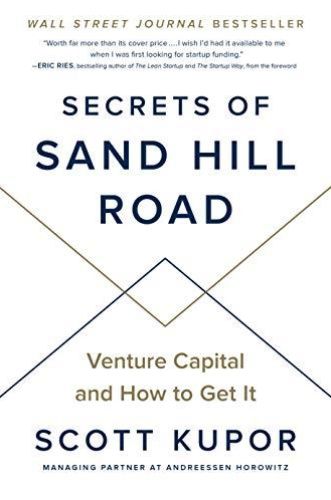Wildly successful venture capitalist Scott Kupor, managing partner at Andreessen Horowitz, provides a welcome and straightforward guide for founders seeking venture capital.

Advice from One Who Knows
By detailing the big-dollar processes of Sand Hill Road in Silicon Valley, Scott Kupor, managing partner at Andreessen Horowitz, provides a primer on venture capital (VC). Kupor moonlights as a professor at Stanford and UC Berkeley, and much of his step-by-step content reads like a course for entrepreneurs or investors, so this is not the tell-all his book title suggests. As any worthy investor does, he repurposes his assets – as a venture capitalist and teacher – to deliver a practical guide to raising capital.
Kupor’s colleagues praise his book, which was a Wall Street Journal bestseller. Eric Reis, best-selling author of The Lean Startup, said, “I wish I’d had it available to me when I was first looking for start-up funding.” And Eric Schmidt, former CEO of Google, commented along the same lines: “I know firsthand the power of the start-up ecosystem and entrepreneurship. This book is the definitive book on navigating VC as part of that.” Most of Kupor’s other book reviews echo these statements, citing the genuine value of his manual.
Secrets of Sand Hill Road follows in the footsteps of another hard-nosed handbook, Zero To One, written by Silicon Valley veteran Peter Thiel. Another apt ancillary read is Brad Feld and Jason Mendelson’s Venture Deals. Both books offer heaping helpings of their authors’ philosophies while delivering plainspoken, actionable advice.
A Crucial Cog
Kupor begins by reminding readers that risk-taking investors have been around for centuries. Queen Isabella of Spain, the author points out, invested in Christopher Columbus’s excursion, although she thought his venture would fail. In the 1800s, JP Morgan backed inventor Thomas Edison. By the 1990s, venture capital supported Netscape, Cisco and Amazon. Kupor offers the remarkable fact that the VC industry invested $84 billion in start-up businesses in 2017.
But, the author cautions, the VC model has changed. He explains that Silicon Valley VCs do more than fund: They help entrepreneurs tailor their business models, navigate rapid growth and deal with management issues.
Potential Gains
Kupor clarifies that venture capitalists don’t mind frequent strikeouts, as long as they connect for the occasional home run. He notes that 50% of venture-backed start-ups vaporize some or all their invested money; another 20% to 30% produce solid but unspectacular returns.
In VC, all we really care about is the at bats per home run.Scott Kupor
A $5 million bet yielding a $10 million payday, the author insists, won’t make up for all the losses. VCs want massive wins – returns of 10 to 100 times the initial investments.
People, Product and Market Size
Kupor’s firm looks for founders with a self-confidence that borders on delusion – “egomaniacs.” When it comes to products, VCs think in terms of vitamins versus aspirin: Vitamins’ benefits might take years to appear, but an aspirin brings immediate relief. VCs pursue aspirin-like ideas that offer clear solutions to consumer problems. And Kupor emphasizes that VCs hit home runs by backing start-ups with big market potential.
Limited partners are deep-pocketed investors seeking to diversify their portfolios. Kupor describes the typical LPs, such as university endowments, foundations, pension funds, insurance companies and others. These LPs are desirable investors, Kupor has found, because they understand the long-term nature of VC returns.
Kupor is clear that US start-ups should form as C corporations, which can offer common stock for founders and employees, and preferred stock for VCs and LPs. He also urges entrepreneurs to set up all possible legal protections for their intellectual property.
Size Matters
Kupor is adamant that founders know whether their concepts have sufficient heft to attract venture capital. He says they must make a credible case that, in seven to 10 years, their start-up will generate annual sales of several hundred million dollars.
If the ultimate size of the opportunity isnt big enough to create a stand-alone, self-sustaining business of sufficient scale, it may not be a candidate for venture financing.Scott Kupor
The author believes a tight budget focuses and disciplines a new business. He definitely opposes raising too little money at a rich valuation, which, he feels, forces entrepreneurs to meet aggressive growth goals without adequate backing.
Pitching to VCs
First, Kupor urges, explain your potential market size to likely investors. Then, he says, pitch your team. The author sums up this priority elegantly when he points out that anyone can copy an idea, but few can execute it. Hence, VCs will scrutinize your management team. Kupor further recommends that the founder be a good storyteller.
As uncomfortable as it may be, you need to spend a significant amount of time in your pitch talking about you as the CEO and the rest of your team.Scott Kupor
Kupor discloses that VCs want to know the thinking behind every offering. How did the founder conceive of the idea? Who’s going to buy the product? How much will consumers pay? How will the company market the concept?
Kupor counsels that VCs also want to hear an entrepreneur’s plan for future capital raising. A founder needs a clear policy on how much the company will raise and what milestones it will reach along the way.
Brusque and Businesslike
This reads more like a practical textbook than a run-of-the-mill business book, and in that lies Kupor’s market advantage. He wastes little time on theory or on how things should be. He explains the marketplace clearly, details what VCs want and how entrepreneurs should give it to them, and provides, via lists and scenarios, what founders need to do before, during and after VC funding. Because the stakes are so high in this universe, many present it with more complexity than it warrants. Kupor sees through to the heart of each step of gaining VC funding and supplies that primary vision. His text is easy to read and understand, and he offers the guidance entrepreneurs need to succeed.






